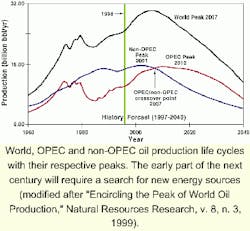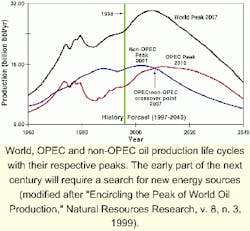GEOSCIENCES
Millennial challenge: expanding the search
As we enter the next millennium, is the world quickly approaching the peak of world oil production? According to Natural Resources Research (International Association for Mathematical Geology), article authors Duncan and Youngquist predict the peak of world oil production during 2007, with a non-OPEC peak during 2001. In their view, OPEC will peak a little later in 2010.
This means there is yet as much oil to produce as the industry has ever produced. It also means that there are a vast number of deposits yet to be found, many (most?) of them offshore. The geoscientist's challenge is to find those reserves in time to fuel consumer needs, thereby maintaining the world's economic stability, while new energy resources are developed.
The petroleum geoscientist's charge of finding and filling the world's energy needs will not change. What will change is the focus on oil resources. A shift will likely take place in the resource search within the next 10 years.
The new millennium will get its start on oil, but a wider richer mix of energy sources will be found and developed. Geoscientists will find the raw resources and our technology tools will continue to be used and perfected, though augmented by new refining processes. The world's need for energy is constantly expanding. Finding the necessary resources is the growing constant and the consummate geoscience challenge in the 21st Century.
So how do we find these remaining oil resources? Where and what do we look for? The search over the last century took geoscientists over most of the globe's land surface, and in the last 50 years has extended that search into the marine environment. This will continue - pushing tools and curiosity into the deepest offshore basins and into the deeper formations of land-locked basins. There are still scores of basins untouched by either seismic or drilling activity.
The first endeavors will be to continue evaluating and extending production from known oil-producing basins. Even in well-developed basins, new provinces and trends exist, just waiting for economics and ideas favorable to frontier exploration. This has occurred repeatedly:
- 1970's - North Sea shelf
- 1980's - West Africa deepwater
- 1990's - Brazilian continental shelf.
Geoscientists will search for large structures first and chase the obvious "sweet spots." But, lest the industry forgets, world-class reserves also rest in major stratigraphic features. Few are seeking these today unless they are in direct association with a traditional structure. None will risk a career-killing prospect in the current environment. The financial management running most companies is very risk-averse.
Sand piles are the current targets of choice - stacked deepwater fans with good seals. Is anyone looking for deepwater carbonate traps? Reefs, mounds, chalk, even buried karst zones, hold major reserves in established plays. We can always hope for serendipity (East Texas Field).
Everything old will be new again, but it will take the recovery of a battered attitude - passionate inquiry. A rekindling of this life-force will discover the next paradigm shift in understanding. Like plate tectonics, it will be aided by technology (worldwide 2D in its case). The search for the new paradigm lies in 3D/4C, slimhole cores, paleontologic zonation, pore chemistry history, or some other currently obscure corner. Focus and passion will likely find it. The present geoscientific economies are trapped in older exploration fomularies.
EXPLORATION
Southern Atlantic
TGS Geophysical announced agreements with Phillips and Chevron Overseas Petroleum to license their non-exclusive 2D survey in the Santos, Campos and Espirito Santo Basins offshore Brazil. Acreage in these basins is expected to be opened for licensing by the Agencia Nacional do Petroleo in the near future.
Eastern Atlantic
TGS-NOPEC plans to send the Zephyr-1 to Portugal/Morocco to begin a new non-exclusive survey.
Australia
The Australian Geological survey Organization is expecting an increase in activity this year as a result of the recent strong oil prices. In 1999 35 offshore exploration wells were drilled, down twenty wells from 1998. The Northwest Shelf continues to be the focus of exploration activity.
TECHNOLOGY
New number-cruncher
Veritas DGC completed the installation of its new NEC SX-5/6B vector supercomputer in Singapore. It is the most powerful vector supercomputer in the Asia-Pacific region and will be used to meet demand for 3D imaging and depth migration processing. The system has six CPUs with a peak performance of 48 gigaflops. A main memory of 32 gigabytes (GB), bandwidth of 384 GB per second, and disk storage of 12 terabytes of HIPPI RAID support the CPUs. The new system is connected to the company's network by a 100 megabyte per second connection. "Initial results show that performance expectations have been met, with many processing steps achieving close to the expected four-fold improvement over the previous SX-4 system that it is replacing," reported Ted Mariner, Vice President of Advanced Hardware and Software Systems.
Immersive workroom
Western Geophysical opened the Western VIEWtrademark (virtual immersive environment workroom) facility at its Isleworth office in London. Craig Beasley, Vice President of Global Data Processing for Western said the facility provides a virtual environment designed to cater to the demands of multidisciplinary work groups that are rapidly becoming the norm in the oil and gas industry.

